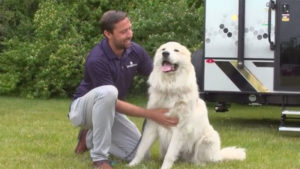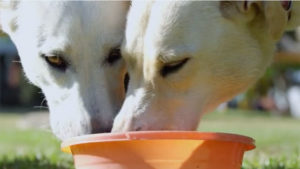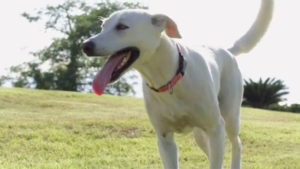rving with pets
Heat Exhaustion and Heat Stroke with Dr. Fitz for 'Paws on Board'
Dr. Fitz: Welcome to Rollin’ On TV’s Paws on Board. I’m Dr. Fitz, and this is Bruno. Today we’re going to be discussing heat stroke versus heat exhaustion. A large proportion of RVers bring their pets with them on their travels, somewhere around 70%. Whether you plan to hang out in the campground or explore the trails, you should consider the safety of your dog. During the summer months, many popular vacation spots can get extremely warm and humid.
 Just like people, canines can become dehydrated and be impacted by the heat. Any dog can be affected, but several breeds have special considerations. Double-coated breeds like Bruno here, they have two layers of insulation. There’s some argument that their insulation can keep them cool. But just the same, the excess insulation could also make them overheat, if they’re exerting themselves or playing fetch. Brachycephalic dogs or the smoosh-faced dogs include pugs, Boston terriers, French bulldogs, Boxers, Cavaliers, among others. They have a different anatomy of their airway. Their airway is a little smooshed, so it’s not conducive to optimal air flow, and they can often struggle to get sufficient oxygen when they exercise, and they actually have a reduced ability to keep themselves cool. Many vets actually recommend limiting outdoor activity for these breeds in the warmer months.
Just like people, canines can become dehydrated and be impacted by the heat. Any dog can be affected, but several breeds have special considerations. Double-coated breeds like Bruno here, they have two layers of insulation. There’s some argument that their insulation can keep them cool. But just the same, the excess insulation could also make them overheat, if they’re exerting themselves or playing fetch. Brachycephalic dogs or the smoosh-faced dogs include pugs, Boston terriers, French bulldogs, Boxers, Cavaliers, among others. They have a different anatomy of their airway. Their airway is a little smooshed, so it’s not conducive to optimal air flow, and they can often struggle to get sufficient oxygen when they exercise, and they actually have a reduced ability to keep themselves cool. Many vets actually recommend limiting outdoor activity for these breeds in the warmer months.
 Older dogs or dogs that have breathing issues or hearts or airway disease, they also have reduced ability to get oxygen and to cool themselves, as well. So, keeping in mind all those breeds, any dog is at risk for heat-related injuries, given the right conditions. Dogs primarily use panting, like Bruno here, to cool, and only sweat minimally through their paws. Excessive panting in a dog can actually be dangerous and lead to hyperventilation.
Older dogs or dogs that have breathing issues or hearts or airway disease, they also have reduced ability to get oxygen and to cool themselves, as well. So, keeping in mind all those breeds, any dog is at risk for heat-related injuries, given the right conditions. Dogs primarily use panting, like Bruno here, to cool, and only sweat minimally through their paws. Excessive panting in a dog can actually be dangerous and lead to hyperventilation.
 Dr. Fitz: In the warmer months, you should be aware of the difference between heat stroke and heat exhaustion. Both conditions actually look very similar, but they vary in how they can occur; however, both are medical emergencies. Heat exhaustion occurs in a warm, humid environment like today. Usually, the dog has lost a lot of fluid by panting and even sweating a little bit through their paws. Often, they’ll be a little dehydrated, and this can cause a drop in blood pressure. When a dog has heat exhaustion, surprisingly, their temperature’s actually normal, and this is because their body is working extra hard to cool themselves off. Because of this and the dehydration, you’ll often see a dog that is a bit weak. They might be nauseous, so they might throw up. They might look a little uncoordinated or a little drunk. They’ll pant excessively. Their gums might be a bit red, and they can even collapse if it gets bad enough. All these signs are because their body is working so hard to cool themselves off and keep their body temperature normal. If you notice these signs in your dog, get them to a cool, shady location and provide cool water; however, when you do this, make sure you provide the water in small amounts. You don’t want your dog to inhale air, as well as the water. You can also place a cool, wet towel–so, you can take some water and wet a towel, and place that on your dog. This can help cool them and allow them to release heat that way; however, if your dog doesn’t improve with these basic cooling measures, get them to a veterinarian. They usually will need some fluids and supportive care to keep them cool.
Dr. Fitz: In the warmer months, you should be aware of the difference between heat stroke and heat exhaustion. Both conditions actually look very similar, but they vary in how they can occur; however, both are medical emergencies. Heat exhaustion occurs in a warm, humid environment like today. Usually, the dog has lost a lot of fluid by panting and even sweating a little bit through their paws. Often, they’ll be a little dehydrated, and this can cause a drop in blood pressure. When a dog has heat exhaustion, surprisingly, their temperature’s actually normal, and this is because their body is working extra hard to cool themselves off. Because of this and the dehydration, you’ll often see a dog that is a bit weak. They might be nauseous, so they might throw up. They might look a little uncoordinated or a little drunk. They’ll pant excessively. Their gums might be a bit red, and they can even collapse if it gets bad enough. All these signs are because their body is working so hard to cool themselves off and keep their body temperature normal. If you notice these signs in your dog, get them to a cool, shady location and provide cool water; however, when you do this, make sure you provide the water in small amounts. You don’t want your dog to inhale air, as well as the water. You can also place a cool, wet towel–so, you can take some water and wet a towel, and place that on your dog. This can help cool them and allow them to release heat that way; however, if your dog doesn’t improve with these basic cooling measures, get them to a veterinarian. They usually will need some fluids and supportive care to keep them cool.
 Heat stroke is slightly different than heat exhaustion. It occurs when there’s an inability of the dog to lose heat. So, some of those breeds that I mentioned earlier, like the smoosh-faced dogs, those tend to be the worst when it comes to heat stroke. They’re compromised in some way, and they can’t cool themselves. So often in dogs that have heat stroke, they’ll have an elevated body temperature versus a normal body temperature. In dogs, a normal body temperature can range from 99.5 to 102.5 degrees. So, they run much warmer than we do as people. In a dog with heat stroke, they’ll be often very lethargic. They may collapse. They can vomit and have diarrhea. They will be excessively panting like with heat exhaustion, but they can also eventually have seizures, if the condition gets bad enough. Heat stroke is dangerous, and it can be life-threatening, because the temperature, body temperature is elevated, and that can actually cause internal organ damage. If this occurs, you want to use the same cooling measures as you would for heat exhaustion. So, again, applying a cool, wet towel, giving your dog some water, and getting them to a cool, shady location. We want to avoid that organ damage as much as possible. When you’re using these cooling measures, you don’t want the body temperature to drop too fast. So, use these in moderation, as your dog improves over time. But like with heat exhaustion, if these measures are not working, and your pet isn’t improving, you need to get them to a veterinarian, as this can be life-threatening. So, what are some things that you can do to avoid heat stroke and heat exhaustion in your dogs when you’re on vacation? Well, first, don’t leave your dog in a hot car or RV, even if you have the windows open. If you do plan to leave your dog in your RV, ensure that it has active ventilation like this RV here. You want to make sure that there’s cool ventilation moving through to keep your dog cool.
Heat stroke is slightly different than heat exhaustion. It occurs when there’s an inability of the dog to lose heat. So, some of those breeds that I mentioned earlier, like the smoosh-faced dogs, those tend to be the worst when it comes to heat stroke. They’re compromised in some way, and they can’t cool themselves. So often in dogs that have heat stroke, they’ll have an elevated body temperature versus a normal body temperature. In dogs, a normal body temperature can range from 99.5 to 102.5 degrees. So, they run much warmer than we do as people. In a dog with heat stroke, they’ll be often very lethargic. They may collapse. They can vomit and have diarrhea. They will be excessively panting like with heat exhaustion, but they can also eventually have seizures, if the condition gets bad enough. Heat stroke is dangerous, and it can be life-threatening, because the temperature, body temperature is elevated, and that can actually cause internal organ damage. If this occurs, you want to use the same cooling measures as you would for heat exhaustion. So, again, applying a cool, wet towel, giving your dog some water, and getting them to a cool, shady location. We want to avoid that organ damage as much as possible. When you’re using these cooling measures, you don’t want the body temperature to drop too fast. So, use these in moderation, as your dog improves over time. But like with heat exhaustion, if these measures are not working, and your pet isn’t improving, you need to get them to a veterinarian, as this can be life-threatening. So, what are some things that you can do to avoid heat stroke and heat exhaustion in your dogs when you’re on vacation? Well, first, don’t leave your dog in a hot car or RV, even if you have the windows open. If you do plan to leave your dog in your RV, ensure that it has active ventilation like this RV here. You want to make sure that there’s cool ventilation moving through to keep your dog cool.
Next, make sure that you provide adequate water for your pets. Dogs can drink about a liter of water per day, depending on their size. Likely, they’ll need more, especially if they’re being active or if they’re in a warm environment. So, make sure you have extra water with you at all times. Finally, make sure to give your dog breaks from the heat, so that they have time to cool off in between all the fun and all the hikes.
For more information about traveling safely with your pets, visit RollinOnTV.com. Tune in next time for more pet health information. I’m Dr. Fitz, and this is Bruno.
Thanks for watching
Paws on Board.


